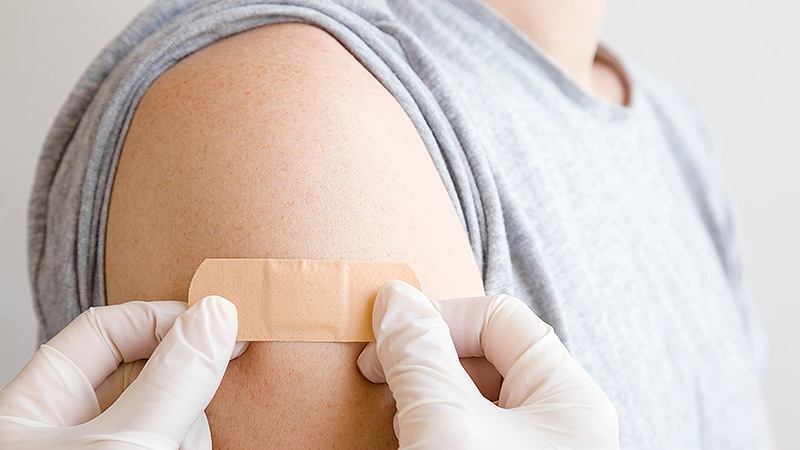
[ad_1]
Some of the celebration and excitement over the approval of COVID vaccines has been dampened by recent reports of allergic complications. Twenty-one cases of confirmed anaphylaxis have been identified after administration of the first 1.8 million doses of Pfizer-BioNTech vaccine (approximately 1 in 87,000 injections). Although rare, this risk is significantly higher than the risk associated with other vaccines (1.3 per million).
So far, the majority of episodes of anaphylaxis have occurred within 30 minutes of receiving the vaccine and have responded quickly to treatment. Out of 21 identified case reports, five patients were allergic to food, three of whom also had a history of drug allergy. A total of 12 patients had previously had allergic reactions to drugs or vaccines, and one patient had environmental allergies.
Regarding the Moderna vaccine, a few cases of delayed facial swelling have occurred without serious consequences. The Centers for Disease Control and Prevention (CDC) now recommends a brief observation period after vaccination in a facility capable and prepared to treat anaphylaxis.
So what is the most likely cause of these reactions and how can we keep our patients safe? Here are the answers to some questions you might ask yourself.
Are vaccine allergies common?
Allergy to the vaccine is rare. The cause of these rare allergic reactions to vaccines is usually not the antigen but an excipient – additives which can include antibiotics, preservatives or adjuvants. Meat proteins (gelatin and, rarely, alpha-gal) have also been identified as the causes of IgE-mediated reactions in higher gelatin-content vaccines (MMR and VZV). Therefore, in some cases, atopy (especially food allergy) may be a risk factor for reaction to certain vaccines. On the other hand, the influenza vaccine grown in eggs contains so little egg allergen that it is no longer of concern to patients with even severe egg allergies.
What could be causing anaphylaxis from the COVID-19 vaccine?
It has recently been proposed that the cause of these reactions is the known allergen, polyethylene glycol (PEG), which is present in Moderna and Pfizer vaccines to help stabilize mRNA. PEG has been identified as the cause of reactions to colonoscopy preparations; stool softeners (such as Miralax); and drugs, including topical and parenteral corticosteroids, as well as PEG coated tablets and toothpaste. The high molecular weight of PEG can be immunogenic. IgE and IgG antibodies directed against these excipients, as well as positive skin tests, support it.
Who is at risk for anaphylaxis from the COVID-19 vaccine?
This remains to be determined and may be different for each COVID-19 vaccine. Operating under the assumption that the causative agent may be PEG, patients with a suspected history of IgE-mediated reactions to a stool softener, colonoscopy preparation and other products containing PEGylated products may be considered at risk.
How do you assess the patients who might be at risk?
Skin prick and skin test with PEG-3350 (the polyethylene glycol contained in Miralax stool softener) have been reported and have been positive in some patients with a history of anaphylaxis to this product; the skin test produced a mild urticarial rash with dyspnea and diffuse pruritus. Since there is at least some experience with PEG skin testing, this could be done in patients with a questionable history of PEG allergy. But how to go beyond that would still be unknown territory.
How to manage high risk patients?
The CDC recommends that patients who have an anaphylactic reaction to the first dose of the COVID-19 vaccine not receive the second dose. When the diagnosis is in doubt – for example, in the context of a possible post-vaccination vasovagal reaction – measurement of serum tryptase (SC5b-9, the terminal complement complex) may confirm the diagnosis of anaphylaxis. I advise the interpretation of the test result in consultation with an allergist-immunologist. A history of anaphylactic reaction to a polysorbate (such as PEG) is also a contraindication to Pfizer and Moderna vaccines.
How should we manage patients with vaccine contraindications?
The Johnson & Johnson COVID-19 vaccine uses an adenovirus vector rather than mRNA. For patients who may have had anaphylaxis after the first dose but in whom the reaction is in serious doubt, an allergist may consider performing a sequential challenge scratch test. It is questionable whether it is worth the risk, as the first dose of vaccine is moderately effective and an alternative vaccine is on the horizon.
Gary J. Stadtmauer, MD, is an allergist-immunologist in New York City. His areas of clinical interest include asthma, eczema, chronic cough and sinusitis. He has been a Medscape contributor since 2014.
Follow Medscape on Facebook, Twitter, Instagram and YouTube
[ad_2]
Source link